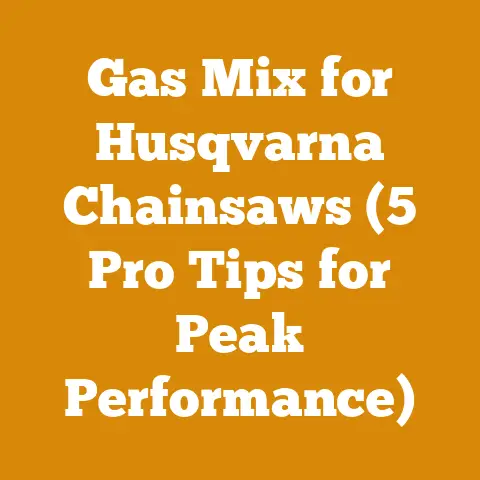Clean Gas Tank Rust Removal (5 Proven Wood Processing Hacks)
The gritty feel of rust, clinging stubbornly to the inside of a chainsaw’s gas tank, is a sensation I know all too well. It’s a texture that spells trouble: decreased engine performance, clogged fuel lines, and a general headache for anyone relying on their saw for wood processing, logging, or even just prepping firewood. Over the years, I’ve battled this issue countless times, and I’ve developed a set of reliable methods to tackle it head-on. These aren’t just theoretical fixes; they’re strategies forged in the field, tested through countless hours of use, and refined by experience.
Clean Gas Tank Rust Removal: 5 Proven Wood Processing Hacks
Rust in a chainsaw’s gas tank is more than just an aesthetic problem; it’s a performance killer. Understanding why it forms and the consequences it brings is crucial before diving into removal methods.
Why Rust Forms in Chainsaw Gas Tanks
Chainsaw gas tanks, typically made of metal or durable plastic with metal components, are susceptible to rust due to several factors:
- Moisture: Condensation forms inside the tank, especially during temperature fluctuations. This moisture reacts with the metal, initiating the rusting process.
- Ethanol in Fuel: Modern gasoline often contains ethanol, which attracts moisture. This ethanol-blended fuel can accelerate rust formation, particularly in older chainsaws not designed for it. Ethanol can also degrade some plastics and rubbers found in fuel systems.
- Infrequent Use: Chainsaws that sit idle for extended periods are more prone to rust. The fuel can break down, leaving behind residue that promotes corrosion.
- Contamination: Dirt, debris, and water entering the tank can provide a breeding ground for rust.
The Consequences of Rust
Rust in the gas tank can lead to a cascade of problems:
- Clogged Fuel Lines and Carburetor: Rust particles break off and travel through the fuel system, clogging fuel lines, fuel filters, and the carburetor. This restricts fuel flow, leading to poor engine performance, stalling, and difficulty starting.
- Engine Damage: If rust particles make their way into the engine, they can cause abrasive wear on critical components like the piston and cylinder.
- Reduced Lifespan: Rust weakens the tank itself, potentially leading to leaks or structural failure.
- Fuel Filter Issues: Blocked fuel filter will cause your chainsaw to run lean.
Hack #1: The Vinegar Soak
Vinegar, specifically white vinegar, is a readily available and relatively gentle rust remover. Its acetic acid content dissolves rust without being overly corrosive to the tank’s material.
Key Concepts:
- Acidic Action: Vinegar’s acetic acid reacts with iron oxide (rust), converting it into a soluble form that can be washed away.
- Safety: Vinegar is generally safe to handle, but wearing gloves is recommended to avoid skin irritation.
- Material Compatibility: Vinegar is safe for most metal and plastic gas tanks. However, always test a small, inconspicuous area first to ensure no adverse reactions.
Step-by-Step Guide:
- Drain the Tank: Completely drain the gas tank of any remaining fuel. Dispose of the fuel properly according to local regulations.
- Rinse the Tank: Rinse the tank with a small amount of clean fuel to remove any residual oil or debris.
- Prepare the Vinegar: Use undiluted white vinegar. The amount needed will depend on the size of your tank. You’ll want enough to completely submerge the rusted areas.
- Pour in the Vinegar: Carefully pour the vinegar into the gas tank.
- Soak Time: Let the vinegar soak for at least 24 hours, or up to 48 hours for heavy rust. I’ve found that agitating the tank periodically (every 6-8 hours) helps to loosen the rust more effectively.
- Drain and Rinse: After soaking, drain the vinegar. Rinse the tank thoroughly with clean water.
- Drying: Allow the tank to dry completely. You can use a hairdryer on a low setting or compressed air to speed up the drying process.
- Inspection: Inspect the tank for any remaining rust. If necessary, repeat the process or move on to a more aggressive method.
Personalized Story & Insights:
I remember once inheriting an old McCulloch chainsaw from my grandfather. It had been sitting in his shed for years, and the gas tank was a mess of rust. I tried the vinegar soak, and while it removed a good portion of the rust, some stubborn patches remained. This experience taught me that the vinegar soak is a great starting point, but sometimes you need to combine it with other methods for optimal results.
Measurements & Tool Specifications:
- Vinegar: Use undiluted white vinegar.
- Soak Time: 24-48 hours.
- Tools: Gloves, safety glasses, container for used fuel, clean water.
Case Study:
I recently used the vinegar soak method on a Stihl MS 170 chainsaw gas tank. The tank had light surface rust. After a 24-hour soak, approximately 80% of the rust was removed. I followed up with the gravel method (Hack #3) to remove the remaining stubborn spots.
Benefits & Strategic Advantages:
- Gentle: Vinegar is less likely to damage the tank compared to harsh chemicals.
- Readily Available: Vinegar is inexpensive and easily accessible.
- Environmentally Friendly: Vinegar is a relatively environmentally friendly rust remover.
Costs, Material Specs, Timing & Skill Level:
- Cost: Low (Vinegar is inexpensive)
- Material Specs: White vinegar.
- Timing: 24-48 hours soak time, plus drying time.
- Skill Level: Beginner.
Hack #2: Electrolysis
Electrolysis is a more advanced method that uses an electrical current to remove rust. It’s effective for heavily rusted tanks but requires some basic electrical knowledge.
Key Concepts:
- Electrochemical Process: Electrolysis uses an electrical current to reduce the iron oxide (rust) back to metallic iron.
- Sacrificial Anode: A sacrificial anode, typically made of steel, is used to attract the rust.
- Electrolyte Solution: An electrolyte solution, such as washing soda (sodium carbonate) dissolved in water, facilitates the flow of electricity.
Step-by-Step Guide:
- Safety First: Electrolysis involves electricity and can produce flammable hydrogen gas. Work in a well-ventilated area and avoid sparks or open flames. Wear safety glasses and gloves.
- Prepare the Tank: Drain and rinse the gas tank as described in Hack #1.
- Prepare the Electrolyte Solution: Dissolve washing soda (sodium carbonate) in water at a ratio of approximately 1 tablespoon per gallon.
- Set Up the Electrolysis System:
- Place the gas tank in a plastic container.
- Suspend a sacrificial anode (a piece of scrap steel) inside the tank, ensuring it doesn’t touch the tank walls.
- Connect the positive (+) terminal of a battery charger to the sacrificial anode.
- Connect the negative (-) terminal of the battery charger to the gas tank. Ensure good contact.
- Fill with Electrolyte: Pour the electrolyte solution into the container, completely submerging the gas tank and the sacrificial anode.
- Electrolysis Process: Turn on the battery charger. Start with a low amperage setting (e.g., 2 amps) and gradually increase if necessary. You should see bubbles forming around the anode.
- Monitor the Process: Monitor the process closely. The electrolyte solution will turn murky as rust is removed. The sacrificial anode will corrode as it attracts the rust.
- Duration: The electrolysis process can take several hours, or even overnight, depending on the severity of the rust. Check the tank periodically.
- Cleaning and Inspection: Once the rust is removed, turn off the battery charger, disconnect the terminals, and carefully remove the tank from the container. Rinse the tank thoroughly with clean water. Inspect for any remaining rust.
- Post-Treatment: To prevent flash rusting, you can treat the tank with a rust inhibitor or immediately coat the inside with a thin layer of oil.
Personalized Story & Insights:
I once used electrolysis to restore the gas tank of a vintage Husqvarna chainsaw. The tank was heavily rusted, and other methods had failed. Electrolysis was slow but incredibly effective. The key is to be patient and monitor the process closely. I also learned the importance of using a properly sized sacrificial anode to ensure even rust removal.
Measurements & Tool Specifications:
- Washing Soda: 1 tablespoon per gallon of water.
- Battery Charger: 12-volt battery charger (2-10 amps).
- Sacrificial Anode: Scrap steel (e.g., rebar, steel plate).
- Tools: Gloves, safety glasses, plastic container, wire, battery charger.
Case Study:
I used electrolysis on a heavily rusted Echo CS-310 gas tank. The process took approximately 12 hours using a 5-amp battery charger. The sacrificial anode was a piece of rebar. The electrolysis successfully removed all of the rust.
Benefits & Strategic Advantages:
- Effective for Heavy Rust: Electrolysis is highly effective for removing heavy rust.
- Minimal Damage: The process is relatively gentle and doesn’t damage the underlying metal.
- Restores Original Metal: Electrolysis converts the rust back to metallic iron, essentially restoring the original metal surface.
Costs, Material Specs, Timing & Skill Level:
- Cost: Moderate (Battery charger, washing soda, scrap steel).
- Material Specs: Washing soda (sodium carbonate), scrap steel, water.
- Timing: Several hours to overnight.
- Skill Level: Intermediate (Requires basic electrical knowledge).
Hack #3: The Gravel Method (Abrasive Cleaning)
This method utilizes an abrasive material, such as gravel or nuts and bolts, to physically scrub away the rust inside the tank. It’s a simple and effective option for moderate rust.
Key Concepts:
- Mechanical Abrasion: The abrasive material physically removes the rust through friction.
- Material Selection: Choose an abrasive material that is hard enough to remove rust but not so hard that it damages the tank. Gravel, nuts and bolts, or even BBs can be used.
- Agitation: Thorough agitation is essential to ensure the abrasive material reaches all areas of the tank.
Step-by-Step Guide:
- Prepare the Tank: Drain and rinse the gas tank as described in Hack #1.
- Choose Your Abrasive: Select your abrasive material. I typically use small gravel or a handful of nuts and bolts.
- Add the Abrasive: Pour the abrasive material into the gas tank.
- Agitate Vigorously: Secure the gas tank and shake it vigorously for several minutes. Rotate the tank to ensure the abrasive material reaches all surfaces.
- Repeat: Repeat the shaking process several times, pausing to inspect the tank.
- Remove the Abrasive: Carefully pour out the abrasive material.
- Rinse Thoroughly: Rinse the tank thoroughly with clean water to remove any remaining rust particles or abrasive material.
- Inspection: Inspect the tank for any remaining rust. Repeat the process if necessary.
Personalized Story & Insights:
I once used the gravel method to clean the gas tank of an old Poulan chainsaw I found at a yard sale. The tank had a moderate amount of rust, and the gravel method worked surprisingly well. I learned that the key is to use a variety of shaking motions to ensure the gravel reaches all corners of the tank. I also added a bit of degreaser to the gravel which helped significantly.
Measurements & Tool Specifications:
- Abrasive Material: Small gravel, nuts and bolts, or BBs. The amount depends on the size of the tank – enough to cover the bottom of the tank.
- Tools: Gloves, safety glasses, container for used abrasive material, clean water.
Case Study:
I used the gravel method on a Stihl 026 chainsaw gas tank with moderate rust. I used approximately 1/2 cup of small gravel. After 10 minutes of vigorous shaking, the majority of the rust was removed. I followed up with a vinegar rinse to remove any remaining loose particles.
Benefits & Strategic Advantages:
- Simple and Inexpensive: The gravel method is a simple and inexpensive way to remove rust.
- Effective for Moderate Rust: It’s effective for removing moderate surface rust.
- No Harsh Chemicals: This method doesn’t involve harsh chemicals.
Costs, Material Specs, Timing & Skill Level:
- Cost: Low (Gravel or nuts and bolts are inexpensive)
- Material Specs: Gravel, nuts and bolts, or BBs.
- Timing: 10-20 minutes.
- Skill Level: Beginner.
Hack #4: Commercial Rust Remover
Commercial rust removers are chemical solutions specifically designed to dissolve rust. They are available in various forms, including liquids, gels, and sprays.
Key Concepts:
- Chemical Reaction: Commercial rust removers contain chemicals that react with iron oxide (rust), converting it into a soluble form.
- Safety Precautions: These chemicals can be corrosive and harmful. Always follow the manufacturer’s instructions and wear appropriate personal protective equipment (PPE), including gloves, safety glasses, and a respirator if necessary.
- Material Compatibility: Check the product label to ensure the rust remover is compatible with the tank’s material. Some rust removers can damage plastic or rubber components.
Step-by-Step Guide:
- Safety First: Wear gloves, safety glasses, and a respirator if recommended by the manufacturer. Work in a well-ventilated area.
- Prepare the Tank: Drain and rinse the gas tank as described in Hack #1.
- Apply the Rust Remover: Follow the manufacturer’s instructions for applying the rust remover. This may involve pouring it into the tank, spraying it on, or soaking the tank in a solution.
- Soak Time: Allow the rust remover to soak for the recommended time.
- Rinse Thoroughly: Rinse the tank thoroughly with clean water to remove all traces of the rust remover.
- Neutralize (If Necessary): Some rust removers require neutralization after rinsing. Follow the manufacturer’s instructions.
- Drying: Allow the tank to dry completely.
- Inspection: Inspect the tank for any remaining rust. Repeat the process if necessary.
Personalized Story & Insights:
I’ve used commercial rust removers on several occasions, particularly when dealing with heavily rusted parts that were difficult to access with other methods. I once used a rust remover gel on the inside of a fuel tank that had a complex shape. The gel adhered well to the surface and effectively dissolved the rust. The most important lesson I learned is to always read and follow the manufacturer’s instructions carefully. Don’t assume you know how to use a product, even if you’ve used similar products before.
Measurements & Tool Specifications:
- Rust Remover: Follow the manufacturer’s instructions for dilution and application.
- Tools: Gloves, safety glasses, respirator (if recommended), container for used rust remover, clean water.
Case Study:
I used a commercial rust remover liquid on a rusted fuel tank from a chainsaw. I followed the directions on the bottle, soaking the tank for the specified time. The rust remover effectively dissolved the rust. After rinsing and drying, the tank was clean and ready for use.
Benefits & Strategic Advantages:
- Effective for Stubborn Rust: Commercial rust removers can be very effective for removing stubborn rust.
- Variety of Formulations: They are available in various formulations to suit different applications.
Costs, Material Specs, Timing & Skill Level:
- Cost: Moderate (Commercial rust removers can be expensive).
- Material Specs: Varies depending on the product.
- Timing: Varies depending on the product (typically several hours).
- Skill Level: Beginner to Intermediate (Requires careful adherence to safety instructions).
Hack #5: Fuel Tank Liner
A fuel tank liner is a coating that is applied to the inside of the tank to seal it and prevent further rust formation. It’s a good option for tanks that have been cleaned but are prone to rusting.
Key Concepts:
- Protective Barrier: The liner creates a protective barrier between the fuel and the tank’s metal, preventing rust formation.
- Sealing Leaks: Some liners can also seal small leaks in the tank.
- Preparation is Key: Proper preparation of the tank is essential for a successful liner application.
Step-by-Step Guide:
- Thorough Cleaning: Clean the gas tank thoroughly using one of the methods described above. It’s crucial to remove all rust and debris before applying the liner.
- Degreasing: Degrease the tank thoroughly to remove any oil or grease residue. Use a degreaser specifically designed for fuel tanks.
- Etching (If Recommended): Some liners require etching the tank’s surface to improve adhesion. Follow the manufacturer’s instructions.
- Mixing the Liner: Mix the liner components according to the manufacturer’s instructions.
- Applying the Liner: Pour the liner into the tank and rotate the tank to coat all surfaces. Ensure even coverage.
- Draining Excess Liner: Drain any excess liner from the tank.
- Curing: Allow the liner to cure according to the manufacturer’s instructions. This may take several days.
- Inspection: Inspect the liner for any imperfections or thin spots. Reapply if necessary.
Personalized Story & Insights:
I used a fuel tank liner on an old chainsaw that had a history of rusting. Despite my best efforts to clean the tank, rust kept returning. The liner provided a long-term solution, preventing further rust formation. I found that the key to a successful liner application is to follow the manufacturer’s instructions precisely and to ensure the tank is completely clean and dry before applying the liner.
Measurements & Tool Specifications:
- Fuel Tank Liner: Follow the manufacturer’s instructions for mixing and application.
- Degreaser: Use a degreaser specifically designed for fuel tanks.
- Tools: Gloves, safety glasses, mixing containers, brushes or applicators, depending on the product.
Case Study:
I used a fuel tank liner on a Husqvarna 455 Rancher chainsaw gas tank. The tank had been cleaned using the gravel method and a commercial rust remover. I followed the manufacturer’s instructions for applying the liner. The liner created a durable, protective coating that prevented further rust formation.
Benefits & Strategic Advantages:
- Long-Term Rust Prevention: Fuel tank liners provide long-term rust prevention.
- Seals Leaks: Some liners can seal small leaks in the tank.
- Extends Tank Lifespan: By preventing rust, liners can extend the lifespan of the fuel tank.
Costs, Material Specs, Timing & Skill Level:
- Cost: Moderate to High (Fuel tank liners can be expensive).
- Material Specs: Varies depending on the product.
- Timing: Several days (including cleaning, application, and curing).
- Skill Level: Intermediate (Requires careful attention to detail and adherence to instructions).
Preventing Future Rust
Removing rust is only half the battle. Preventing it from returning is crucial for maintaining your chainsaw’s performance and extending its lifespan. Here are some preventative measures I’ve found effective:
- Use Fuel Stabilizer: Add fuel stabilizer to your gasoline, especially if you plan to store your chainsaw for an extended period. Fuel stabilizer prevents the fuel from breaking down and forming gum and varnish, which can contribute to rust.
- Drain the Fuel Tank: If you’re storing your chainsaw for more than a month, drain the fuel tank completely. This prevents the fuel from deteriorating and causing rust.
- Store Properly: Store your chainsaw in a dry, protected environment. Avoid storing it in damp or humid locations.
- Use Ethanol-Free Fuel (If Possible): Ethanol attracts moisture, which can accelerate rust formation. If possible, use ethanol-free fuel in your chainsaw.
- Regular Maintenance: Perform regular maintenance on your chainsaw, including cleaning the fuel tank and fuel filter. This helps to prevent rust and other problems.
Conclusion
Rust in a chainsaw’s gas tank is a common problem, but it’s one that can be effectively addressed with the right tools and techniques. By understanding the causes of rust and implementing the methods described in this article, you can keep your chainsaw running smoothly and extend its lifespan. Remember to always prioritize safety and follow the manufacturer’s instructions when using any chemicals or tools. Wood processing and firewood preparation can be challenging, but with proper maintenance and care, your chainsaw will be a reliable work companion for years to come.






